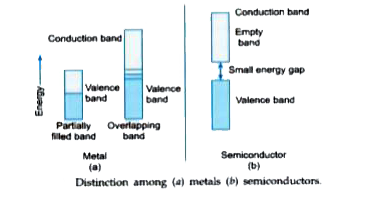In terms of band theory, explain the difference between a conductor and a semiconductor and give one example of each.
Conductor : Solids which have conductivities in the range of 104 to 107ohm−1m−1 are called conductors. Metals have conductivities of the order of 107ohm−1m−1. The atomic orbitals of metal atoms form molecular orbitals which are close in energy to each other so as to form a band. If the band is partially filled or it overlaps with a higher energy unoccupied conduction band, then electrons can easily flow to the conduction band.
Semiconductor : Solids which show conductivity in the range 10−20 to 10−10ohm−1m−1 are called semiconductors. The gap between the valence band and conduction band is small. Therefore, some electrons jump to the conduction band and show some conductivity. The following figure illustrates.

Topper's Solved these Questions
- SOLID STATEBOOK - U-LIKE SERIESCHAPTER - SOLID STATEEXERCISE - LONG ANSWER QUESTION - I
20 Videos
- SOLID STATEBOOK - U-LIKE SERIESCHAPTER - SOLID STATEEXERCISE - SELF ASSESSMENT TEST
8 Videos
- SOLID STATEBOOK - U-LIKE SERIESCHAPTER - SOLID STATEEXERCISE - VERY SHORT ANSWER QUESTIONS
35 Videos
- SAMPLE QUESTIONS PAPER BOOK - U-LIKE SERIESCHAPTER - SAMPLE QUESTIONS PAPER EXERCISE - SECTION D
6 Videos
- SOLUTIONBOOK - U-LIKE SERIESCHAPTER - SOLUTIONEXERCISE - SELF ASSESSMENT TEST (SECTION D)
2 Videos
Similar Questions
Knowledge Check
The energy band gap (difference between conductor band and valance band) in semiconductors is
A0 eVB1 eVC5 eVDnone of these
In terms of band theory, what is the difference between
a. a condcutor and an insulator
b. a conductor and a semiconductor
View SolutionExplain the difference between a homogeneous and heterogeneous catalyst. Give an example of each.
View SolutionIn terms of band theory, what is the difference
(i) between a conductor and an insulator,
(ii) between a conductor and a semiconductor ?
View SolutionIn terms of band theory, what is the difference between
a. a condcutor and an insulator
b. a conductor and a semiconductor
View SolutionIn terms of band theory, what is the difference between
a. a condcutor and an insulator
b. a conductor and a semiconductor
View SolutionExplain the difference between intrinsic semiconductors and extrinsic semiconductors.
View SolutionDistinguish between a conductor , a semiconductor and an insulator on the basis of energy band diagrams.
View Solution
